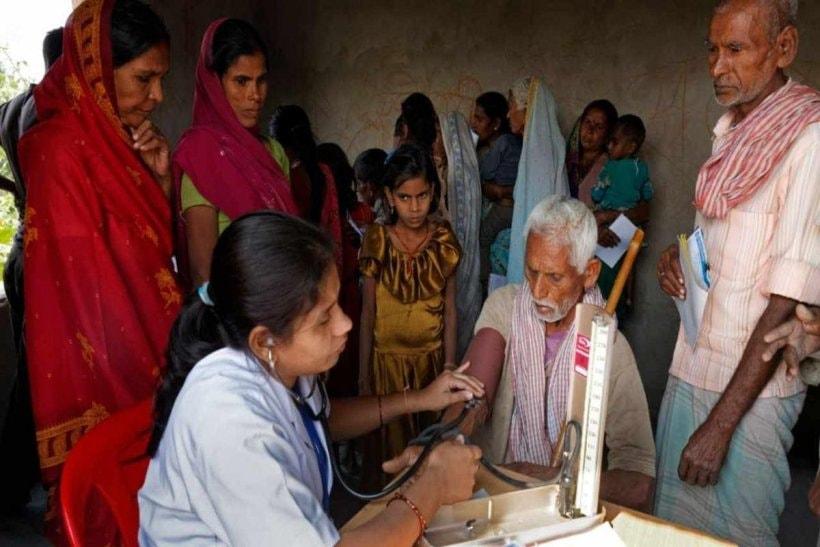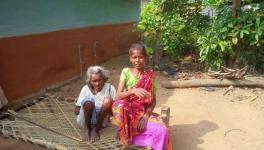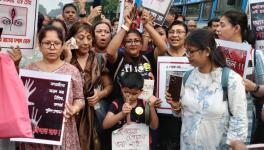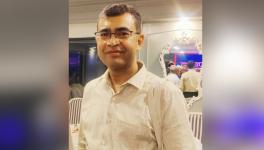West Bengal: Why Rural Healthcare is Failing and Making Room for Quacks

Free health check up being done at a village under National Rural Health Mission (2013) programme.
Representational Image. Image Courtesy: Facebook(NRHM)
Kolkata: Shakti Sadhan Das, a 36-year-old father of two, is a resident of Kumirmari village of Hingalganj block of Sundarbans. His family in Kumarimari village includes his ageing parents, whose ailments put Das at a loss as the nearest healthcare centre is around 5 kilometres away in Bainara.
Even if one manages to reach the Bainara Primary Healthcare Centre, one would be faced with an understaffed facility without doctors. The nurses at the centre are only tasked with vaccinating children and undertaking the TB-Dot programme. Patients are usually rushed to the hospital in Khulna, a block healthcare centre around 12 km from Das' village.
The Khulna hospital also has staffing issues; as a result, patients are regularly referred to the sub-divisional hospital in Bashirhat or the tertiary centres in Kolkata.
Talking to NewsClick, Das said healthcare conditions in the region have deteriorated over the years; it was better during the government of the Left Front.
"Now everything is coloured blue and white, but no real treatment is available from the government-run health centres," he added.
Das also said residents of his village and nearby villages were entirely dependent on quacks to treat their ailments.
"We are forced to take quacks' help as no alternatives are available," he said.
The situation described by Das applies to healthcare services in other villages in rural West Bengal, too.
As per West Bengal Rural Health Survey 2021, the vacancies for doctors in the state have increased in the last 16 years. In 2004, as many as 441 positions were vacant; that number has increased to 578 in 2021.
The number of sanctioned posts marginally decreased in this period, from 1,560 sanctioned posts in 2005 to 1,533 posts in 2021, a trend not visible in other states.
NURSING STAFF IN PHCs IN RURAL AREAS
In the case of nursing staff vacancies, the state showed a similar trend compared with the countrywide picture; in 2005, there were 422 vacancies, which increased to 1,688 in 2021. Against 7,597 sanctioned posts, only 5,909 have been filled.
Each sub-centre in the overall healthcare system in West Bengal covers a population of around 5,000-7,000. Only Uttar Pradesh, Jharkhand, and Bihar fare worse in this parameter. Each Primary Health Centre (PHC) covers a population of over 50,000, putting the state among the lowest-rung ones, along with UP, Bihar and Jharkhand.
‘FAILING’ PUBLIC HEALTH INFRASTRUCTURE
NewsClick spoke to three eminent physicians associated with the public health movement in West Bengal regarding the “failing” condition of rural healthcare -- Dr Fuad Halim, Dr Subrana Goswami (joint secretary, Association of Health Service Doctors), and Dr Satyajit Chakraborty (former general secretary, Association of Health Service Doctors).
Halim talked about how failing public health infrastructure in rural healthcare was proving to be dangerous in West Bengal. He said that peripheral primary and secondary healthcare institutions had been deprived of the resources and equipment to deliver basic healthcare services to the population.
"To check the deteriorating condition of the patients, the peripheral hospitals are referring these cases (citing shortage of staff) to hospitals in Kolkata and the tertiary centres. On the other hand, the outpatient departments of the apex institutions had a huge footfall; for example, PG hospital had a footfall of over one lakh patients/day, which was then celebrated as a success by the state government. The overcrowding of apex hospitals and the referrals to the apex institutions is a testament to the deteriorating planning affecting West Bengal healthcare."
Halim also said that West Bengal was yet to provide statistical output to the Union Health Ministry about various verticals related to healthcare.
"This clearly shows that all is not well in the health sector in West Bengal. In the sample figures, we can see that the maternal mortality rate has gone up instead of decreasing in West Bengal, making the state the only place in Asia and sub-Saharan Africa where the maternal mortality rate has increased. On the other hand, we have seen that the caesarean section in the private sector has shot up. The Family Health Survey 2019-20 shows that private practitioners are being motivated by the insurance money to do caesarean section and its incidence is highest in the state. The World Health Organisation (WHO) has identified that caesarean sections should not exceed 10-15% of total deliveries. These statistics show that the West Bengal government is moving like a headless chicken as far as healthcare infrastructure, delivery and policy are concerned."
Halim also recalled that PHCs were adequately staffed during the Left regime, achieving close parity with national guidelines.
"Now the policy redirection toward specialty centres and physical infrastructure in terms of the building has been created. Still, human infrastructure and material resources that deliver super-specialty healthcare are yet to be provided, leading to the super-specialty hospitals being named as such, but delivering services far below expectations. Resource re-mobilisation toward super-specialty hospitals has further weakened primary and secondary rural healthcare networks in West Bengal," he added.
The absence of a robust healthcare system accessed by the common people has given rise to a set of people embedded with the socio-cultural structure, who are trusted by the local people because of their availability. These people, called quacks, are popular in areas where access to health has not yet been made possible by the private, public or corporate medical sector.
‘GOVT-RUN HEALTHCARE MUST BE PRIORITISED’
Subarna Goswami talked about how the target set by the National Health Mission has not been achieved. She recalled that the plan to augment the rural health network was taken during the United Progressive Alliance-1 government (National Rural Health Mission 2005); later, it was merged with the Urban Health Mission and became the NHM.
"In between, due to the COVID pandemic, some impetus was there. Public health units are being constructed at the block level, and new recruitments for data managers and other healthcare professionals are being carried out. At the sub-centre level, the development of these into wellness centres under a community health officer is being discussed. From here, telemedicine and non-communicable diseases like fever, cancer, hypertension, palliative care, senior care, and mental health care are being taken up. However, there is no improvement in primary health, and the target of 50,000 catering to one PHC still needs to be achieved. More than 5,000-5,500 PHCs are yet to be constructed. In West Bengal, many PHCs need medical professionals. As the health budget is not increasing, only a meagre 1.16% of GDP (Gross Domestic Product) is allocated towards healthcare, not even near the prescribed 2.5% of GDP that should be towards healthcare," she said.
Goswami further said there were no doctors and nurses in PHCs, and health prevention was suffering due to increased emphasis on insurance culture.
"Government-run healthcare needs to be strengthened to the desired extent. The corporate sector is now extending toward rural people. The steps that the UPA-I government had taken for preventive medication through reaching all the households with running water, the impetus for rural employment, stoppage of open defecation, and the shortage of allocation towards this, under the present Union Government's regime, has meant along with India, West Bengal has also suffered."
Goswami compared the healthcare conditions in West Bengal with that in Kerala.
There are many more historical reasons in Kerala, such as missionary education and women's education. It is non-comparable with Bengal as the present Kerala government is thoroughly adept in people's participation in health and has tackled the pandemic situation with professionalism. Tamil Nadu recently has also passed a health rights Bill which is also a step toward providing quality healthcare. In West Bengal, cosmetic changes are being made, but no real investment is being made in infrastructural issues like doctors and nurses. Those who are coming to government hospitals are those who are being forced to do so," she added.
Goswami highlighted how the public sees the huge buildings but does not see the lack of infrastructure. As a result, when patients die, the relatives break valuable assets of the healthcare centres and attack doctors and nurses.
"For example, in North Bengal Medical College, many operations, including neurosurgery, are not done. In super-specialty hospitals, the condition is even more serious. The private healthcare network does not believe in preventive medicine and will not invest in preventive medicine in rural areas and urban slums. What is needed is government investment. If indices of preventive medicine like sanitation, employment, maternal education, and sanitation are made, then the state government has to make new schemes for its population," Goswami said.
In West Bengal, there is a myth that doctors do not want to go to the villages. At the same time, the fact is that there is no living arrangement available for doctors below the PHC level, and the old quarters are dilapidated and unlivable.
"Under these circumstances, who will go to these remote places to stay and practice medicine? Also, after 1977, the rural allowance of medical practitioners has remained the same. It is a meagre Rs 200, while many states provide twice the salary of urban practitioners as incentive to go to rural places."
Satyajit Chakraborty detailed the various components of the healthcare system in West Bengal.
"In the government system, the most peripheral stages are the sub-centres (where there is an ANM (auxiliary nurse-midwife) and an ASHA (accredited social health activist) worker, linked with the local ICDS Centre. The PHCs are the second stage, and the block hospitals are above it. This is the set-up of the rural health network in West Bengal. Now the condition is such that an MBBS is posted in block primary health centres (BPHC). An upgraded BPHC is known to be a rural hospital and should have a gynaecologist, a paediatrician, and an anaesthesiologist. Three to four MBBS doctors should be posted in an upgraded BPHC," he said.
Earlier, there were doctors in the sub-centres, but now they have been withdrawn in many places. As the sub-centres are dilapidated in West Bengal, the vacuum is being filled up by quacks.
"The sub-centres, now known as wellness centres by the Central government, are now witnessing a new initiative called telemedicine. Under the scheme, another ANM nurse will be posted in the sub-centres along with pharmacists and, through consultation with doctors in the block levels or even in the higher centres, give medicines to the patients. Under this scheme, the role of medical professionals personally seeing the patients gets diluted. By this, in straight language, more people are being taken out of the medical system. Telemedicine can only happen if a junior doctor takes the opinion of a senior doctor."
Chakraborty recalled that during the Left era, there were many government quarters, but now these have been without repairs for the last 12 years at the PHC level.
"Only the positivity of doctors in PHCs can create a robust rural healthcare network in West Bengal,"he added.
As per Chakraborty, the system of ASHA workers started by the UPA government was a positive step, and the government should be tying up with private players, if needed, for pathological services, as at the BPHC level such service is seldom available.
"The buzzword is that the healthcare workforce should be increased at the rural level. Without having trained doctors or an adequate workforce, quality medical services cannot be provided at the rural level. Whether paramedical courses can be started for quacks is another question," he said.
Another issue highlighted by Chakraborty was the urban-oriented nature of the present West Bengal regime.
"There was emphasis on rural health during the earlier government, BPHCs were upgraded, and PHCs were provided with quarters that were properly maintained. Now, under this government, PHCs have no staff; in the sub-centres, only ANM nurses are provided. In the BPHCs, earlier pathology tests were made, but now in most cases, these do not exist. In PHCs, too, no pathology test centres exist. As a result, doctors do not get any job satisfaction while working in PHCs."
Get the latest reports & analysis with people's perspective on Protests, movements & deep analytical videos, discussions of the current affairs in your Telegram app. Subscribe to NewsClick's Telegram channel & get Real-Time updates on stories, as they get published on our website.
























